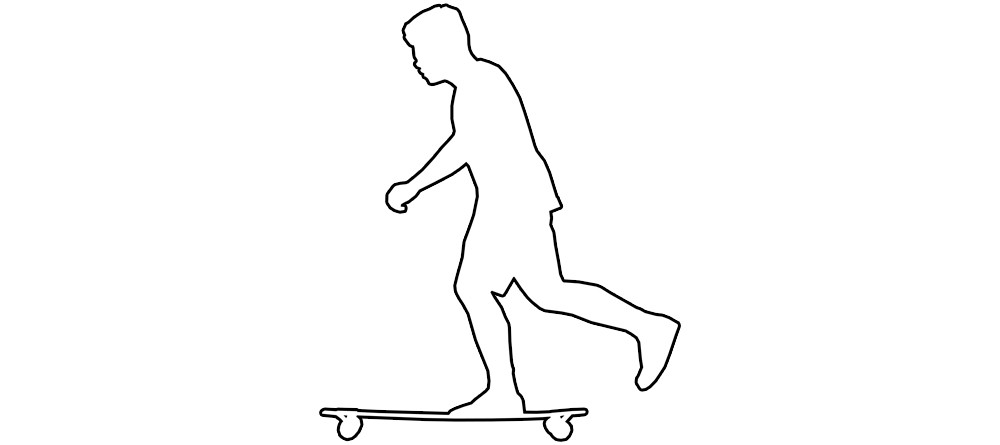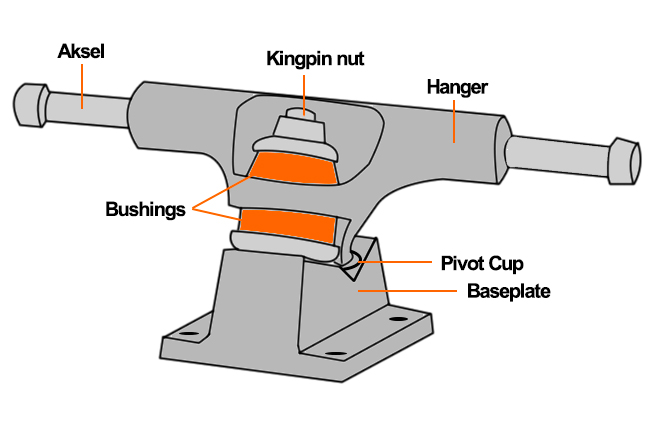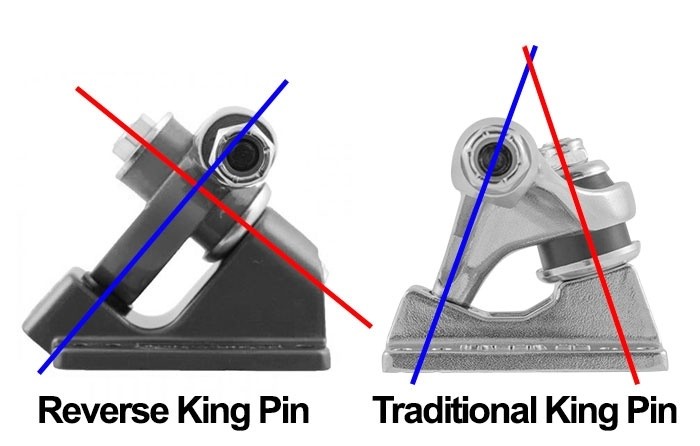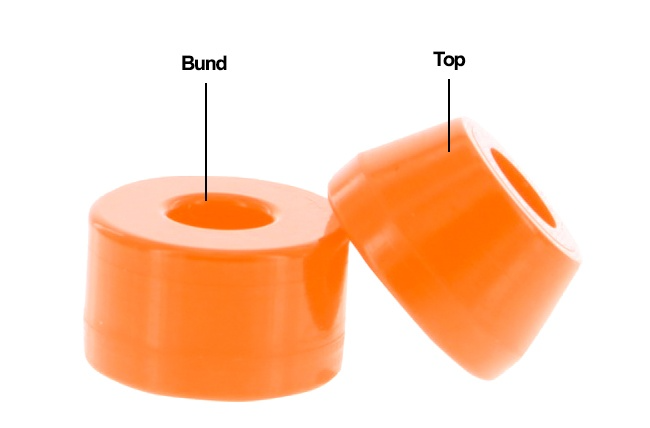Guide for longboard.
Do you want to know what it means when a longboarder is totally stoked because his slides are ‘’buttery’’ or ‘’icy’’? If you want to learn more about the ‘’terms’’ used in longboarding we’ll guide you through the most important in this article! All of us would prefer not to look like a noob. By reading this and (most importantly) understanding this article, you’ll be wiser than 99% of all the longboard skaters out there. In this article, you can look up specific longboard subjects or just find explanations on single words you don’t understand.
Over the last couple of years, the popularity of longboarding has exploded. Both males and females can longboard - the same goes with both adults and kids. Everyone can have fun with these larger boards. You must choose a board that fits the style you want to skate. We will try to give you a better view inside the longboard-world. Look at all our complete longboards right here, you can buy them in the web-shop and in our stores.
How do I start longboarding?
The easiest way to get started is to buy a complete longboard. A complete longboard is a longboard that is ready to ride as soon as you have it in your hand. You can also buy the parts separately and build your own longboard - for example you can buy a longboard deck only, and mount wheels and trucks yourself. You should always remember protection equipment. The bare minimum is to use a helmet! - we also recommend protection for your knees, elbows, and hands.We all have a dominant leg. Most of us are right-legged and prefer to steer with this leg. In longboarding and skateboarding, it is called “regular footed” if your preferred position on the board is with your left foot forward. Conversely, it is called “goofy footed” if you prefer to have your right leg forward. If you do not skate with your preferred leg forward, your riding position is called “switch”.
1.1 Riding styles
You can find tons of different longboarding styles. To understand the following subjects you should know basic longboard and skateboarding keywords. Here is a short description of keywords:
Pushing is the move you do with your leg to push the board forward to keep or gain speed.
Pumping are continuous small turns that are repeated quickly, thus providing propulsion, so you do not have to push.
Sliding is a maneuver performed by turning your board sideways - you start sliding by doing an ultra sharp turn that forces the wheels to lose grip. When the wheels start to slide in a controlled sideways direction you are a pro ;) To be able to practice this, it requires that you have some speed. Sliding is the basis of freeriding.
This is the part where we talk about the styles of riding. As mentioned above, it is important that you decide for yourself what riding style you are most likely to perform. This is important because you should choose a board based on a suitable riding style. This is before buying your first longboard!
Carving: longboards are used to make large or sharp turns similarly to the turns you do on snowboards and partly also on surfboards. When you perform repeated large turns down the hill you can keep a steady speed (=avoiding increased speed) - just like when you do when digging in the edges of your snowboard.Slalom is the term used when riding back and forth cones in a line. The skater must complete a series of minor turns to complete the course. Most often, these longboards are shorter than regular longboards.
2. Short “breakdown” of the parts of a complete longboard
In addition to the deck itself, a complete longboard consists of the three main components - wheels, trucks and ball bearings. Our complete longboard comes standard with components that are carefully selected to give the board specific properties that match the longboard discipline that the board is intended for.2.1 Longboard parts / DECK
A longboard deck is made of wood. The number of Ply/Plies indicates how many layers of maple, bamboo and/or fiberglass veneer (sheet) the board consists of. The glue that holds the veneers together is called lamination. The platform of the longboard is the area on the deck where you can place your feet.The importance of the length of a deck is often overestimated. Actually, it is the distance between the wheels that affects the ability to turn and not the total length of the board. Nevertheless, we have tried to create a simple table that can serve as guidelines for the length of your longboard:
under 70 cm (<20”) Transport and Cruising
70 - 95 cm (28” - 38”) Carving and Freestyle
95 - 107 cm (38” - 42”) Freeride, Carving, Downhill and Sliding
over 107 cm (>42”) Cruising. Downhill and Sliding
Flex is your best friend at low speeds. On the other hand, flex can be your biggest enemy at high speeds! At lower speed, you can take advantage of flex because it increases comfort and fun in general - believe me, it is fun to ride flexy boards! :D Because flexibility of the deck lowers the stability of the board it can be dangerous at higher speeds. We all want to avoid speed wobbles!
2.2 Longboard parts / DECK SHAPES
A board with a directional shape is asymmetrical and is called “directional”. These boards are often used for high speed riding and racing where there is no need to ride switch or “reverse”. A symmetrical board is shaped similarly at both ends and is most often referred to as a “twintip” longboard. It allows you to ride in both directions and is ideal to learn how to ride “switch” on! Kicktails are upturned ends at the front (nose) and/or behind (tail) of a board. With tricktails you can pop the board and do freestyle tricks. You can also do manuals or other tricks. Kicktails offer many opportunities.Cut-outs: seen on twintip boards. Cut-outs are where the deck is cut away - this is done to prevent “wheelbite” when turning sharply. Cut-outs allow you to have large wheels and a low platform on your setup without the wheels biting the deck..
Wheel-wells: a small area on the underside of the deck where material is carved away. Wheels wells are located above the wheels to create clearance when the wheels turn - preventing wheelbite.
Gas-pedals: areas along the edges of the deck where the materials are sanded away and thus provide a more angled edge. It helps you to keep pressure on the edge of the board with your foot. Gas pedals provide increased grip when initiating a slide.
You can see the profile of a deck by looking from the side.
Camber: this profile is exclusive to flexy boards. The deck curves slightly upwards (inverted “U-shape”). It prevents flexible boards from “bottoming out” (the deck is pushed all the way to the ground so that it touches and potentially stops the board).
Rocker: the deck curves slightly down the middle (“U-shape”) when viewed from the side. It provides a more ergonomically correct position and better sense of direction. Good for freeride!
Drop Down Platform: A top mounted board where the platform is lower than the truck mount. The center of gravity is lowered for more stability and comfort for pushing.
Wedged: In this case, the deck is also lowered in the middle (in the same way as dropped decks), but trucks are mounted on the curved nose and tail of the deck. This gives a really good response and is ideal for cruising and especially Carving (maybe also a little Freeride).
W-Concave: this is a special kind of concave. W-concave has a longitudinal ridge centrally located on the platform of the board. It forms a W-shaped bend that can be seen from each end of the board. This type of concave is used for downhill and freeride where board feeling is important.
3D concave: is a change to the natural concave of the deck only located above the wheel wells. This provides additional material for you to press your foot against for better control when sliding. Good for downhill and freeride.
3. “The Truck”
Truck is the term for the component that connects the wheels and the deck. The function of the truck is to turn the longboard. Below we describe how the different parts of the truck itself are denoted.3.1 Longboard parts / TRUCKS
Here we will briefly explain the anatomy of the truck. It has a notable shape and each small part has a special name. See also the picture with arrows and names. Base plate: The part of the truck that is mounted directly to the deck. It is the piece that has holes that match the holes on the deck.Hanger: The hanger contains the axle of the truck and is mounted in the base plate.
Axle: The axle runs through the hanger of the truck and is the part on which the wheels are mounted.
Kingpin: This is the nut that protrudes from the base plate and goes up through the hanger. It is actually the pivot point of the truck and therefore a central part of the truck.
Bushing seat: This is the hollow area of the “truck hanger” where the bushings are located.
Pivot cup: This is the small cup that sits in the base plate and where the hanger fits in, so it can move freely.
Speed rings: Small spacer discs that allow you to tighten your wheels to the truck without damaging your bearings.
Reverse Kingpin: This is the standard truck of longboards. The Kingpin nut is more angled (see photo) and points away from the center of the board. The turning radius is increased which is a compromise gladly will accept as it increases stability significantly.
Truck angle (degree): The angle of your kingpin has a great impact on the riding characteristics. The angle is measured between the kingpin nut and the base plate. Greater angle = smaller turning radius. Less angle = larger turning radius and thus greater stability.
Loose trucks: Loose trucks are used to describe trucks that are either poorly adjusted or adjusted to turn very easily.
Tight trucks: Tight trucks can be found on some trucks of poor quality - but in the PRO longboard world, tight trucks describe a truck that is adjusted to only very little and thus being very stable.
“Rake”: This term is used to describe the hanger of the truck. More precisely, it is used to describe the symmetry of the hanger. Some hangers can be turned upside down and thus give a different truck angle.
Springs: Some trucks have springs. These are typically special trucks that are intended to give a surf feeling.
3.2 Longboard parts / TRUCK ASSEMBLY
Top mount longboards are mounted with trucks just like a traditional skateboard. The base plate is mounted on the underside of the deck and the hardware from the top. This truck mount provides the highest degree of grip and is therefore used for downhill.Drop-through longboards are a type of deck with cutouts in which the baseplates of the trucks can be mounted from the top and hanger from the bottom. You can say that the truck has “dropped through the deck”. This lowers the center of gravity and allows for more stability.
Double-drop longboards are a combination of both a dropped platform and drop-through trucks. Double drops are very low and are often used in Long Distance Push.
3.3 Longboard parts / TRUCK BUSHINGS
All bushings are made of urethane. Hardness of this material is measured on the durometer scale. The material can be shaped in many ways and is therefore used for both wheels and bushings. Bushing shape can change the ability to turn. Here I’ll give a brief overview of the terminology for bushings and what they are good for.The traditional bushing set-up consists of a short cone bushing that sits on the top of the hanger and a higher barrel bushing that sits on the underside of the hanger of the truck.
Barrel bushings: barrel-shaped bushings restrict the movements of the bushing seat. It increases stability and is used for downhill.
Stepped-barrel: is even better for downhill. They can be recognized by their looks - it looks like the bushing has been stepped on. There is more material in the middle than in the top and bottom. This bushing can drop into the actual bushing seat, thus slowing down the movements of the truck even more.
Cones: cone-shaped bushings do not restrict the movements of your trucks. They are great for carving and cruising setups.
4. The longboard must be able to roll! WHEELS AND BALL BEARINGS
All longboard wheels today are made of urethane. Very cheap longboards may have wheels made of PVC. The hardness of the chemical substance urethane is calculated on the durometer scale. There are three scales that are primarily used A, B and D (B and D scales are generally used only in very hard skateboarding wheels). Almost all longboard wheels will be rated on the A scale and the most common durometers range from 78A to 84A.4.1 Longboard parts / THE CONTACT SURFACE OF THE WHEELS
The contact surface of a longboard wheel is the area of the wheel that constantly is in contact with the asphalt. The area is often mistakenly confused with the width of the wheel, but it is not the same. The contact surface can be stone-grounded, which means that the surface is worn a bit already from the manufacturer. The manufacturer does this to make the wheel better for slides from day one.Coning: When you slide a lot on a longboard, the wheels get more worn on the inside than the outside. This way, the wheels can be worn so that they become cone-shaped and this type of wear on the wheels is called coning.
Flat-spots: there may be flat areas on your wheels when you slide and. When you turn your board more than 90 degrees when sliding, the wheel stops rotating and therefore the wheels get worn in one place. Nobody likes flat-spots!!
Longboard parts / WHEEL EDGE
The edge of the wheel can be shaped in different ways. The edge is also called the wheel lip. Below we explain the pros and cons for different wheels lips:Hard lip (squared edge): is a term used for wheels with a hard,sharp and angular edge. These wheels have maximum grip and are ideal for downhill or high speed riding.
Rounded lip: simple enough, the term for an edge that is rounded. This will decrease grip and make sliding easier. Such wheels are ideal for freeriding and sliding.
Bevel: Almost like a rounded wheel that aims to make it easier for the wheels to start sliding. However, it differs as the edge is not rounded but directly cut away. This will maintain an edge of the wheel as you wear it down.
4.3 Longboard parts / WHEEL CORE LOCATION
The area of the wheel that holds the bearings is called the core or hub of the wheel. The properties of the wheel depend a lot on the location of the core. Below we will explain the importance (pros and cons) of the different core locations:Center-set: a center-set core is located directly in the center of the wheel. This means that there is an equal amount of material in contact with the surface on both sides of the core. This core location gives the most grip.
Side-set: the core of the side-set wheel will be set all the way to the edge of the wheel. It provides very little grip because the wheel has very small contact with the ground when turning. If you just started to learn how to sliding, these wheels can help you progress faster.
Off-set: an off-set core sits slightly off-center in the wheel, providing a mix between the two above.
4.4 Longboard parts / BALL BEARINGS
Ball bearings are rated by ABEC - an abbreviation for “Annular Bearing Engineering Committee”. This group of engineers developed a rating system which divides ball bearings according to their precision. Precision in other words means how much the diameter of the balls varie. These values are all the way down to +-0,001 mm. High values are compatible with little variation and thus good quality and smooth bearings good for higher speeds. Not all companies choose to have their products rated by ABEC. Most ball bearings will be made of steel. They roll well, are relatively inexpensive but also very durable. Ceramic balls in ball bearings are easier to machine than steel balls and therefore a much more precise material tho shape. Ceramic ball bearings will not heat up like steel bearings and are ideal for high speed, long distance and downhill riding.Swiss-made bearings are known for their incredible precision. More precision means fewer errors in construction and less chance of unnecessary friction!
Here we will explain the terms that are used when referring to ball bearings for longboarding. See the picture for easier understanding of the terms:
Balls: Ball bearings have a number of balls that are securely located in the retainer. There are 7 balls in ball bearings for longboards.
Inner-race: This is the small ring in the middle of the ball bearing that has direct contact with the axle of the trucks.
Outer-race: This is the larger outer ring that has contact with the wheel itself.
Shield: Ball bearings run best if they are completely clean and freshly lubricated. Most ball bearings therefore have some shielding discs that protect the ball from dirt. There are 2 types of shields: (1) those made of rubber can be removed with a small needle; (2) those made of metal can not be removed. When you want to clean your ball bearings you should definitely remove the ball bearing shields.
Spacers: These are placed between the ball bearings inside the wheel. They are important because they let you tighten your wheels without damaging the ball bearing. I have recently written a post about spacers for (stunt) scooters where I really go in depth why these are important to have in the right size. The same goes for longboards.
5. At high speeds the risk of major damage increases!
I cannot stress this enough! Protect your body - and at least wear a helmet when skating. You cannot do a whole lot without your head.5.1 PROTECTIVE EQUIPMENT
We use protective equipment in two ways: (1) The equipment that protects you from powerful and often unexpected hits which are very violent - but thank God also rare. (2) The equipment that is designed to protect you from minor bumps that you know are unavoidable.The helmet is the most important thing! It should sit tight to your head. For downhill riding, a full-face helmet is used. It resembles a motorcycle helmet and protects the entire head and face.
Slide gloves are an exclusive skating accessory that is only used by longboarders. They do not protect the wrist, but your palms when you at high speeds put them down on the ground to stabilize the ride.
Pucks are the hard plastic blocks found in the palm of your hand.
Pads is the collective term for knee pads and elbow pads.


















